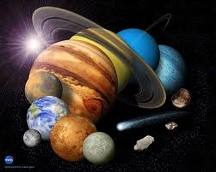Star: A large ball of glowing gas that generates heat and light, through nuclear fission in its cove. Our sun is a star.
Planet: any of the nine large celestial bodies in the solar system that revolves around the sun and shine by reflected light.
light.
Moon (or satellite): the natural satellite of the Earth.
Asteroid: any of numerous small celestial bodies composed of rock and metal that move around the sun (mainly between the orbits of Mars and Jupiter).
Comet: a relatively small extraterrestrial body consisting of a frozen mass that travels around the sun in a highly elliptical orbit.
Solar System: The sun and all the material that orbit it including the planets. The term solar system technically refers only to our own tar (the sun) is often applied to other star systems as well.
Star System: A star (sometimes more than one) and planets and other materials that orbit.
Galaxy: A great island of stars in space, containing from a few hundred to a trillion or more stars, all held together by gravity and orbiting a common center.
Cluster of galaxies: A gigantic region of space3 where many individual galaxies and many, groups and clusters of galaxies are packed more closely together than elsewhere in the universe.
Super cluster: Large groups of smaller galaxy groups and clusters and are among the largest structures of the cosmos.
Universe (or cosmos): The sum total of all matter and energy (example: all galaxies and everything between them)
Observable universe: consists of the galaxies and other matter that we can in principle observe from earth in the present day, because light (or other signals) from those objects has had time to reach us since the beginning of the cosmological expansion
Astronomical unit (AU): a unit of length used for distances within the solar system; equal to the mean distance between the Earth and the Sun.
Light-year: The distance light travels in a year.
Rotation: turn on or around an axis or a center; “The Earth revolves around the Sun”.
Orbit (revolution): the gravitationally curved path of one object around a point or another body.
Or
The (usually elliptical) path described by one celestial body in its revolution about another; “he plotted the orbit of the moon”.
Expansion (of the universe): Outside the local group, the space between galaxy super clusters is expanding in all directions- the expansion of the universe.
Astrology: The foretelling of human disposition and future based on positions of the sun, moon and planets.
Astronomy: The study of origin, evolution, motions, compositions and nature of celestial bodies.
Total Solar Eclipse: When the Moon perfectly blocks the Sun’s disk we only see the outer layer of the sun. People who see the moon’s inner shadow umbra see a total solar eclipse. This is only 270km wide so we only see a small portion from earth.
Partial Solar Eclipse: When the moon blocks only a portion of the Sun’s disk. People who only see the moons outer shadow penumbra see a partial solar eclipse. This can be seen from a much larger portion of the earth.
Annular Eclipse: only a thin outer disk of the sun can be seen. The moon appears smaller form Earth and does not completely block the sun. The name of the eclipse comes from the fact that the ring of the sun is called an “annulus” and it is visible around the dark moon.
Globular Cluster (GC): a spherically shaped cluster of up to one million or more stars. G.C are found primarily in the haloes of galaxies and contain only very old stars
Perigee: Point on Moon’s orbit when the moon is closest to the earth
Apogee: Point on Moon’s orbit when the moon is farthest from the earth
Ki’o parsec (KP): light year
Distance in light years =3.26 x 1000/ p (arc seconds)
Spectroscopy: the study of spectra. The absorption line spectrum shows chemical composition n the atmosphere of the stars.
Distance indicator:any celestial objects for which the luminosity is known or can be obtained without first knowing the distance

wow this was helpful thanks alot. i learned so much i the past 10 min reading all this thank you =)